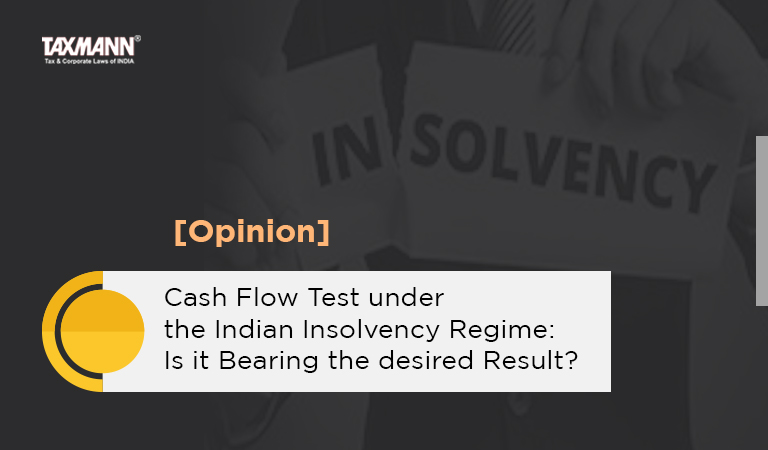[Opinion] Cash Flow Test under the Indian Insolvency Regime: Is it Bearing the desired Result?
- Blog|News|Insolvency and Bankruptcy Code|
- 3 Min Read
- By Taxmann
- |
- Last Updated on 24 December, 2022

[2022] 145 taxmann.com 539 (Article)
I. Introduction
The Indian insolvency regime underwent a roller coaster ride before finally culminating in the Insolvency and Bankruptcy Code, 2016 [hereinafter “the Code“]. The Code brought numerous changes vis-à-vis the previous applicable laws, such as the Companies Act (1956 and 2013). Amongst all other changes, the most notable one was regarding the test employed to assess the financial health of a corporate debtor for initiating the Corporate Insolvency Resolution Process [hereinafter “CIRP“]. Under the Companies Act (1956 and 2013), a company could be wound up if it is, inter alia, unable to pay its debt. Further, ‘inability to pay’ could be determined by using tests such as statutory demand test, judgment test, and a combination of cash flow/commercial insolvency and balance sheet test [hereinafter ‘the Combination test‘]. An entity is considered to be cash flow insolvent if it is not in a position to readily pay its debts as and when they fall due, whereas, balance sheet insolvency occurs when the liabilities of a company exceed the value of its assets. The balance sheet test is broader than the cash flow test as it also considers the contingent and prospective liabilities of an entity along with the existing ones.
With the introduction of the Code, the legislature adopted a restricted version of the cash flow test, i.e., a default-based cash flow test [hereinafter ‘the test‘], wherein the financial health is assessed by the occurrence of a ‘default’. In other words, the CIRP can be initiated against a corporate debtor if it commits a ‘default’, i.e., non-payment of the whole or any part of the debt which has become due. To that effect, even a single instance of default is sufficient to initiate the CIRP against an entity. Of late, the test has struck a discordant note with the judiciary and in addition to a ‘default’, the courts have considered certain other factors to assess the financial position of an entity. Through this article, the authors have attempted to analyse these instances, alongside a comparative analysis with the insolvency test employed in the UK and Singapore, to understand if the test is sufficient to paint a true financial picture of an entity. Additionally, the authors have also discussed the switch from the erstwhile combination test to the present-day test under Indian insolvency.
II. Switch from the Combination Test to the Default based Cash Flow Test
Before the introduction of the Code, it was recommended by the Bankruptcy Law Reform Committee to retain the combination test, as was provided under the Companies Act (1956 and 2013). However, the recommendation did not find its place in the Code and the Parliament retained only the default-based cash flow test. Multiple reasons were cited behind this shift, including, certainty, predictability, primacy to safeguard the economic interest of a corporate debtor over the cause of default in the situation of financial distress. In the landmark case of Swiss Ribbons (P) Ltd. v. Union of India, the court discussed this shift and stated that:
“64. The trigger for a financial creditor’s application is non-payment of dues when they arise under loan agreements. It is for this reason that Section 433(e) of the Companies Act, 1956 has been repealed by the Code and a change in approach has been brought about. Legislative policy now is to move away from the concept of “inability to pay debts” to “determination of default”. The said shift enables the financial creditor to prove, based upon solid documentary evidence, that there was an obligation to pay the debt and that the debtor has failed in such obligation.”
As a result, post introduction of the Code, the primary requirements that need to be fulfilled for initiating the CIRP are the existence of ‘debt’ and the occurrence of ‘default’. Undoubtedly, the test has helped in instating predictability and facilitating timely completion of the CIRP, however, its usage as a mere debt recovery tool has turned out to be a nightmare for corporate debtor. Resultantly, the courts in multiple cases have adopted a cautious approach and have taken into account various other significant factors while admitting an insolvency application. These cases have been discussed in detail in next part of the paper.
Click Here To Read The Full Article
Disclaimer: The content/information published on the website is only for general information of the user and shall not be construed as legal advice. While the Taxmann has exercised reasonable efforts to ensure the veracity of information/content published, Taxmann shall be under no liability in any manner whatsoever for incorrect information, if any.

Taxmann Publications has a dedicated in-house Research & Editorial Team. This team consists of a team of Chartered Accountants, Company Secretaries, and Lawyers. This team works under the guidance and supervision of editor-in-chief Mr Rakesh Bhargava.
The Research and Editorial Team is responsible for developing reliable and accurate content for the readers. The team follows the six-sigma approach to achieve the benchmark of zero error in its publications and research platforms. The team ensures that the following publication guidelines are thoroughly followed while developing the content:
- The statutory material is obtained only from the authorized and reliable sources
- All the latest developments in the judicial and legislative fields are covered
- Prepare the analytical write-ups on current, controversial, and important issues to help the readers to understand the concept and its implications
- Every content published by Taxmann is complete, accurate and lucid
- All evidence-based statements are supported with proper reference to Section, Circular No., Notification No. or citations
- The golden rules of grammar, style and consistency are thoroughly followed
- Font and size that’s easy to read and remain consistent across all imprint and digital publications are applied





